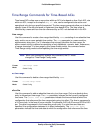
Quality of Service (QoS) Commands
514
ProSafe Managed Switch
with the iSCSI session information acquired by snooping.
Maximum of 16 TCP ports can be configured either bound to IP or
not.
Format iscsi target port tcp-port-1 [tcp-port-2.… tcp-port-8] [address
ip-address] [name targetname]
Mode
Default
tcp-port
ip-address
targetname
no iscsi target port
This command is to delete iSCSI port/s, target, use the no form of this command.
Format no iscsi target port tcp-port-1 [tcp-port-2.… tcp-port-8] [address
ip-address]
Mode
iscsi cos
The iscsi cos Global Configuration mode command sets the quality of service profile that will
be applied to iSCSI flows.
Note: SCSI flows are assigned by default to the highest VPT/DSCP
mapped to the highest queue not used for stack management or
voice VLAN. The user should also take care of configuring the
relevant Class of Service parameters for the queue in order to
complete the setting.
Setting the VPT/DSCP sets the QoS profile which determines the
egress queue to which the frame is mapped. The switch default
Global Config
3260 and 860, but they can be removed as any other configured target
Term Definition
TCP port number or list of TCP port numbers on which iSCSI target/s listen to
requests. Up to 16 TCP ports can be defined in the system in one command or by
using multiple commands.
IP address of the iSCSI target. When the no form is used, and the tcp port to be
deleted is one bound to a specific IP address, the address field must be present.
iSCSI name of the iSCSI target. The name can be statically configured; however, it can
be obtained from iSNS or from sendTargets response. The initiator MUST present both
its iSCSI Initiator Name and the iSCSI Target Name to which it wishes to connect in the
first login request of a new session or connection.
Global Config


















